Chinese Name: 蒙顶山 Pronunciation: Méng Dǐng Shān
Height: 1,456 meters
Suggested Visiting Hours: 1 Day
Mountain Tourist Area: 45 square kilometers
Address: Mingshan County, Ya’an City, Sichuan Province
| Time | Ticket |
| Peak Season (April 1st - October 31st) |
52 yuan |
| Shoulder Season (November 1st - March 31st) |
45 yuan |
People under 65 years old during national holidays (with valid ID card) can buy the half-price ticket.
1. Free for seniors aged 65 or over 65 (with valid ID card);
2. Free for people under 65 years old during non-national holidays (with ID card);
3. The above policy is only applicable to the admission fee.
| Contents | Ticket |
| Cableway up | 15 yuan (one-way) |
| Cableway down | 15 yuan (one-way) |
| Cableway round trip | 30 yuan |
| Line A of Rambling on the Tree Crown | 28 yuan (one-way) |
| The whole line of Rambling on the Tree Crown | 98 yuan (one-way) |
| World Tea Culture Museum | 10 yuan |
| Time | Opening Hours |
| Peak Season (April-October) |
8:00-18:00 |
| Low Season (November-March) |
8:00-17:30 |
Mengding Mountain is located at Mingshan County, Ya’an City, Sichuan Province, southwest of Sichuan Basin. It is about 10 kilometers long and 4 kilometers wide. It is also one of the first provincial-level natural and cultural heritage and a national AAAA scenic spot.
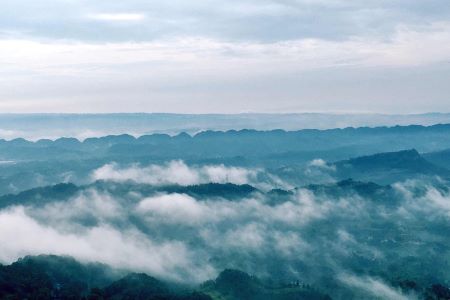
Looking west from Mengding Mountain, we can see Mount Emei, Mount Wawu and Mount Zhougong. Looking down to the east, mountains are undulating, streams are crisscrossing, and the spectacular view is just like pictures. Mengding Mountain has five peaks. The highest peak is named Shangqing Peak, 1,456 meters above sea level.
Mengding Mountain, Emei Mountain and Qingcheng Mountain are the three famous mountains in Sichuan province since ancient times. Among them, Mengding Mountain enjoys the longest history and culture. In 1935, on the way of the Long March of the Red Army, a large number of revolutionary cultural relics were left in Mengding Mountain and are still vivid today.
Besides its marvelous scenery, the mountain also possesses another specialty—tea. Known as the “holy mountain of the world tea culture”, Mengding Mountain serves as the birthplace of the world tea culture and the starting point of the Ancient Tea and Horse Road between Sichuan and Tibet. When it comes to tea, we all know a prevalent saying: “Like the water in Yangtze River, the Mengdingshan tea has the top quality.”
In the winter of 1935, the Fourth Front Army of the Red Army launched a battle in Baizhangguan (now Baizhangguan Town, Mingshan County, Ya'an City) against the Sichuan Army of the Kuomintang(a major political party in Taiwan province, the Republic of China). The fierce battle lasted for seven days and seven nights. This battle became a turning point for the military operation of the Fourth Red Front Army. Mengding Mountain has not only a beautiful natural landscape but also a site with the revolutionary spirit.
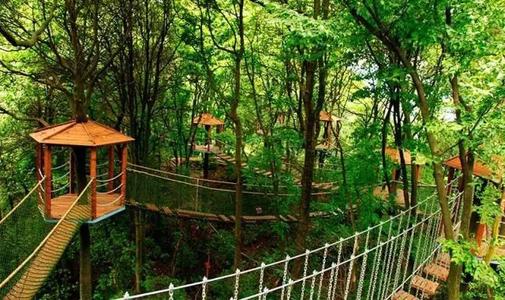
Rambling on the tree crown is China’s largest high-end forest amusement project and is next to the Memorial Hall of the Red Army’s Battle in Baizhangguan. The project is about 1.2 meters long and hidden in the dense forest. It is connected by a 33-tree view platform, which will give you a wonderful journey of the perfect integration with nature.
The Yongxing Temple is on the west side of the hillside of Mengding Mountain, with an altitude of 1,000 meters. The building area is 5,000 square meters. The temple was founded in the Three Kingdoms period and renamed the Great Sanskrit Academy later, meaning “Sanskrit far spread three thousand circles, each with its heart and get the solution”.

In the Tang (618-907) and Song (960-1279) Dynasties, the temple was called “Longquan Temple” and “Mengquan Temple”, then it was renamed “Yongxing Temple” in the Qing Dynasty(1636-1912) meaning long prosperity.
The Yongxing Temple consists of three lanes, five halls, and four courtyards. In the Song Dynasty, the Buddhist monk Budong from the Western Regions came here to collect sutras.
The Grand Hall in the temple is of double eaves and overhanging mountain style and there are three stone buildings with a width of 12 meters. The columns, beams, and walls are all stone structures. There are more than ten stone inscriptions of poetry steles, imperial edicts, and couplets written by Huang Yunhu, a scholar and high-ranking official in Sichuan Province.
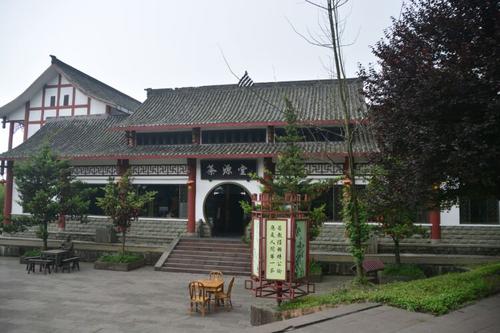
The Memorial Hall of the Red Army’s Battle in Baizhangguan is located in the Shangqing Peak, one of the five peaks of Mengding Mountain. It was first established in 1935 and then was demolished and reconstructed. The new museum covers 1,100 square meters.
The name of the museum was inscribed by Lin Jiamei, wife of the former Chinese President Li Xiannian and a member of the national committee of the Chinese People’s Political Consultative Conference. In front of the museum, there is a tree which was used by General Xu Xiangqian to “tie his horse”. At present, the museum has been officially awarded as the “Youth Patriotism Education Base” by Sichuan Provincial Government.

The Manna Stone Cottage is next to Emperial Tea Garden. It is a single room building of stone structure with double slope roofs in the Ming Dynasty, composing of the stone gate, stone column, stone wall, stone beam, stone overhanging eaves, and stone roof.
According to legend, it is the resting place of Wu Lizhen, who was the pioneer of tea planting in the Western Han Dynasty (202 BC-8 AD), so there is a statue of him in the cottage.
There is a widespread story about the Manna Stone Cottage. In 1935, during the Red Army’s arrival in Mengding Mountain, there were 12 local landlords and bullies who were punished by the Red Army by the stone steps outside the cottage. And later, on both sides of the stone gate, there are the couplets: “the towering and dangerous peak declares the causes of Yu, Pengying’s beautiful landscape shaped from heaven”, and the banner “the marvelous scenic spot of Mengshan Mountain”.
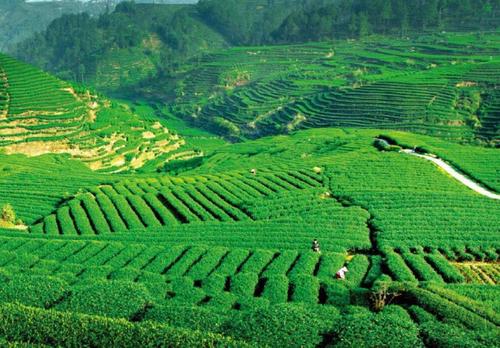
The Emperial Tea Garden was built in the Tang Dynasty and is located at the five peaks. It is said that the five peaks are similar to a lotus, and the garden is in the lotus’ heart. There are seven strains of fairy tea in the garden planted by Wu Lizhen. And there is a saying that “five peaks are pointing to the sky, and seven trees are standing in the palm”.
The Emperial Tea Garden covers about 3.5 square meters, surrounded by stone columns palisade, with bars of 1.2 meters tall. In front of the garden, there is a double stone door. And on both sides, there is a couplet “Yangtze River water, Mengding Mountain tea”.

The Tiangai Temple, founded in the Han Dynasty and rebuilt in the Song Dynasty, is the highest building in Mengding Mountain. The temple covers an area of 8,000 square meters. And its gate is different from other temples because it has 90 nails on it, which is a symbol of the prominent status in ancient times.
In the center of the temple is the temple of the Tea God, which is enshrining Wu Lizhen, the ancestor of tea. Emperor Xiaozong of the Song Dynasty granted him “bodhisattva with nectar, inclusive and beneficial”, and later generations naturally regarded him as a bodhisattva to worship. Wu Lizhen is worshiped by people who are interested in tea culture very much.
Around the temple, there are twelve towering ancient ginkgo trees, and in the center of the temple, there is the stone pillar hall of the Ming Dynasty (1368-1644) building, where is the tea planting place of Wu Lizhen.
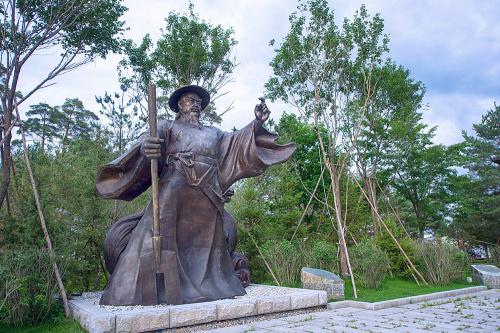
The Statue of Da Yu (founder of the Xia Dynasty) was carved by Sichuan Fine Arts Institute in 1986. It is 5.3 meters tall and stands on top of the stone base. It is said that there was a prevailing plague while Da Yu was trying to control the flood. And Da Yu went to Mengding Mountain to collect tea for people to treat their diseases. Therefore, later generations carved this statue to memorize him.
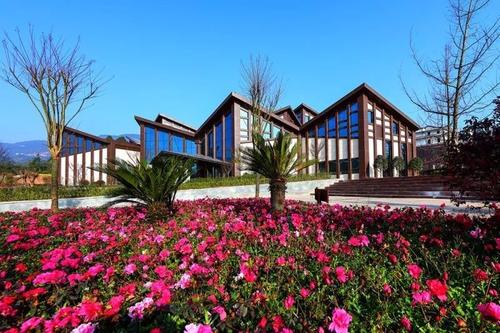
The Tea Culture Museum covers an area of 2,700 square meters and is the only one at the “world” level of China’s tea culture museums. It includes seven exhibition areas: the Theme Pavilion, the Scene Exhibition Area of the Tea and Horse Ancient Road, the Exhibition Area of Tea Knowledge, the Exhibition Area of Tea Culture History, the Exhibition Area of Tea Art Customs, the Mengding Mountain Tea, and the Recreation Area.
The museum displays the origin, development, evolution, planting, production technology of Mengding tea and the tea culture we learnt comprehensively shows the features of Mengding Mountain, the birthplace of world tea culture and the holy place of world tea culture.
The museum provides a great place to visit, exchange, and discuss tea culture with Chinese and foreign experts who are interested in tea culture.
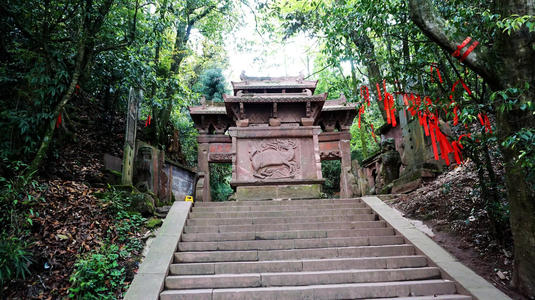
The Yin-Yang Stone Archway was carved in 1622. It is at the gate to the five peaks of Mengding Mountain. And on the stone archway, Buddhist Sanskrit was engraved, which reflects the strict hierarchy of the feudal society, and also proves that tea and Buddhism are inextricably intertwined.
The front relief of the Yin-Yang Stone Archway is one of China’s four mascots (dragon, phoenix, Kylin, and tortoise). And the relief is a “five dissimilar” mascot and was constructed according to people’s wishes. Its head and feet are wet, and the body is dry all year round. This strange phenomenon is consistent with the saying of “clouds and fog on the head, feet step in the sea”. People are all surprised by the peculiar feature when they see the mascot. And the Kylin boasts a reputation both at home and abroad.
It is confirmed that there is a mysterious pattern. On Mengding Mountain in Mingshan County, Ya’an City, there is a huge, strange pattern: a unicorn on the left and a warrior wearing a feather crown on the right. It is also said that as long as you use the satellite map software, you can see that this pattern covers almost the shady surface of Mengding Mountain. But until now, no one knows what is it and why it appears.
At the entrance of The Emperial Tea Garden of Mengding Mountain in Mingshan County, Sichuan Province, there is a peculiar Yin-Yang Stone Kylin. It looks like a kind of “five dissimilar” mascot: the head of a dragon, the body of fish, the back of deer, the tail of a horse, and the foot of sheep.
Route 1: The Travel Route on Red Army’s History and Culture
The Memorial Hall of the Red Army’s Battle in Baizhangguan → A Cliff with Fog and Cloud → Baiyun Pavilion → Wanglang Platform → Trench of the Red Army
Route 2: The Travel Route on Tea Culture History and Relics
Chayuan Hall → The Tea Temple → The World Tea Culture Museum → Stand off the Cableway → Take the cableway → Tiangai Temple → An Old Tea Tree in Millennium → Yin-Yang Stone Archway → Ancient Mengquan (Manna Well) → The Statue of Dayu →The Kiosk of Penglai→ The Emperial Tea Garden → The Peak of Jade Girl (Mengcha Fairy Girl) → The Manna Stone Cottage
Route 3: The Travel Route of Back Hill Walkway
Cableway Station → Waterfall → Hualu Pool → Ginkgo Inn, Ginkgo Restaurant and Shopping → Xiangbi Rock → Yinshen Rock → Baihu Rock → Chanhui’s Hut → Sanjiao Pavilion → Cangjing Rock → Yingzui Rock → Yundong Crossdrift → Shuchen Rock → Sifang Pavilion → Green Screen and Morning-sunlight → Long Rock → Beautiful Sceneries of Mengding Mountain → Panlong Pavilion → Eight Immortals Palace → Tianxian Pool → Yuanwang Pavilion
The best time to travel to Mengding Mountain is from July to October because you will enjoy the most beautiful scenery at that time.
Chinese: 请带我去蒙顶山。English: Please take me to Mengding Mountain.
If you go to Mengding Mountain from the Chengdu city center (Rhombus Park Aura Chengdu Hotel), it takes about 2 hours and 10 minutes (about 370 yuan).
If you go to Mengding Mountain from Chengdu Shuangliu International Airport, it takes about 2 hours (about 350 yuan).
If you go to Mengding Mountain from Chengdu Railway Station, it takes about 2 hours and 30 minutes (about 390 yuan).
If you go to Mengding Mountain from Chengdu East Railway Station, it takes about 2 hours (about 390 yuan).
If you go to Mengding Mountain from Chengdu West Railway Station, it takes about 2 hours (about 370 yuan).
If you go to Mengding Mountain from Chengdu South Railway Station, it takes about 2 hours (about 360 yuan).
